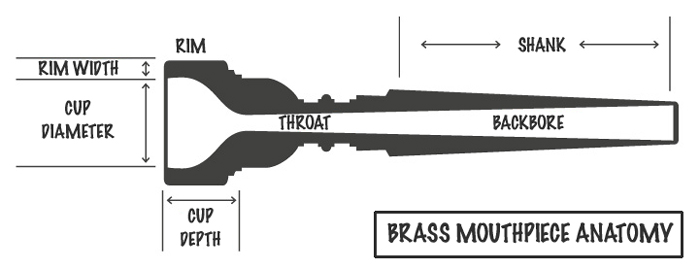Understanding Brass Mouthpieces: A Beginner’s Guide
15th August 2025by Matt Sanders (Dawkes Brass Specialist)
All brass players wonder at one time or another whether or not making a change to their mouthpiece will help. Could it give them more range, more volume or a bigger sound? A change in the mouthpiece can yield fantastic results to the player. You can achieve faster, higher and louder from just a small change.
This beginner’s guide to understanding brass mouthpieces will walk you through the golden rules of choosing the right mouthpiece and explain what all the technical details really mean. We spoke to trombonist Christopher Bill, who shared insights into his current setup using Denis Wick products – and why your own setup can make such a big difference to your playing.

The mouthpiece is the part of the instrument that communicates the sounds and expressions from you to the instrument. Even the smallest change can alter your whole sound.
If you play a brass instrument, choosing a mouthpiece can appear to be a minefield as there are now so many manufacturers. Major brands such as Denis Wick, Vincent Bach, Yamaha and Schilke all make an excellent range of brass mouthpieces. They produce mouthpieces in an abundance of size options. There are also extra choices to make sometimes between heavy top or standard, wide rim or narrow, barrel or V-shape… you get the idea! However, there are some basic brass mouthpiece anatomy facts to know that we have listed below:
Golden rules
- Mouthpiece cup diameter: increasing this will make more of your lips vibrate inside the cup and give a richer sound. However, it may also compromise endurance and stamina. Players will often progress onto wider cups as their embouchure grows stronger.
- Cup depth: a deeper cup gives a fuller sound but makes playing higher more difficult. Shallower cups make high playing much easier but will produce a harsher tone. Some players choose these ‘fast-track’ options but always have to consider the inherent compromises.
- Rim width/ sharpness: a wide rim will make playing for long periods of time very comfortable but will make lip slurring harder. A thinner, sharper rim will vastly improve lip slurring and flexibility. However, it can become very uncomfortable for endurance playing.
- Backbore: this is possibly the most complicated measurement. A wider backbore will make the whole instrument feel and play more openly but this will affect your breathing and endurance. A narrow backbore increases resistance, which can make higher notes easier to hit but gives a very thin sound. It’s best to consider this as part of the wider set of measurements. It’s not something to worry about until the very advanced stages.
- Outer design: this is not just about how the mouthpiece looks, but the distribution of weight around the outside of the cup can have a big impact on the response of the instrument. Adding weight towards the bottom of the cup gives a more focused, intense sound. However, it also reduces the feedback given to you by the instrument. Traditional shaped mouthpieces have a brighter sound and may not carry as far, but can help increase flexibility.
| Feature | Larger / Deeper | Smaller / Shallower |
|---|---|---|
| Cup Diameter | Richer tone, more lip vibration, better low register; requires stronger embouchure | Brighter tone, easier endurance, less depth of sound |
| Cup Depth | Fuller sound, better low register; harder to play high | Easier high register; brighter, sometimes harsher tone |
| Rim Width / Sharpness | Wide = more comfort, less flexibility; good for long playing | Narrow/sharp = better flexibility, lip slurs; less comfort for endurance |
| Backbore | Wide = open feel, bigger sound; less endurance | Narrow = more resistance, easier high notes; thinner tone |
| Outer Design / Weighting | Heavy-bottom = focused, intense sound; less feedback | Traditional shape = brighter, more flexible, less projection |
Christopher Bill’s Trombone Set-Up ft Denis Wick
Christopher Bill shares his current set up: the Denis Wick 12CS. Why does he love this mouthpiece? Because it pairs with his chosen horn, its incredibly free blowing, the projection is ideal for solo playing within funk or jazz settings, allowing the player to cut through and be heard amongst the rest.
Founded in the 1960s by British trombonist Denis Wick, this brand quickly became a benchmark for brass mouthpieces worldwide. Wick designed his first mouthpiece while principal trombone of the London Symphony Orchestra, aiming for precise intonation, exceptional comfort, and a sound that blends beautifully in ensembles.
What makes Denis Wick a great place to start:
- Extensive range: Models for trumpet, cornet, flugelhorn, French horn, trombone, euphonium, and tuba.
- Heritage and design: Each mouthpiece is carefully engineered for clarity, warmth, and projection, making them equally popular with orchestral, wind band, and brass band players.
- Options: Standard, HeavyTop, Heritage (lightweight, vintage-style), and Ultra ranges give players the chance to tailor response and tone.
- Meticulous sizing: Denis Wick sizes are consistent and predictable, making it easier to switch between models without losing your playing foundation.
Denis Wick offer a vast range of mouthpiece options to suit any standard, style and player. Check out Dawkes Music to find an option to suit you.
Why Not Give Some A Try?
We offer a range of Trumpet Mouthpieces, Cornet Mouthpieces, Tenor Horn Mouthpieces, Baritone Horn Mouthpieces, Trombone Mouthpieces and Tuba Mouthpieces. These are all available on a 14 day approval service to allow you to test the mouthpieces in your own environment, take to your lesson or try in band before you commit.
Why not contact us for some advice? We can help point you in the right direction, whether you are the parent of an advancing child or if you are an experienced professional. Our award-winning team can help you find the right mouthpiece.
